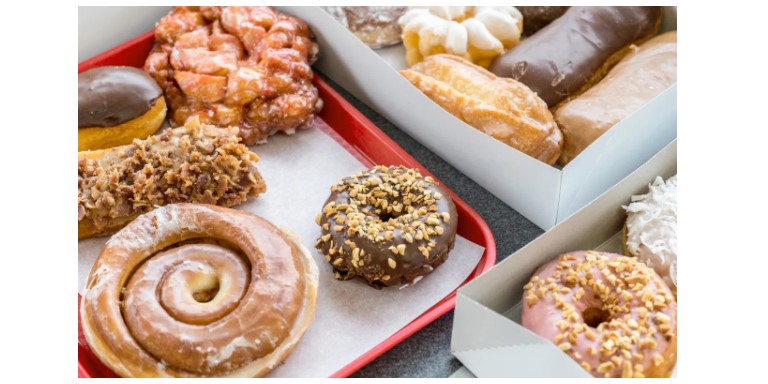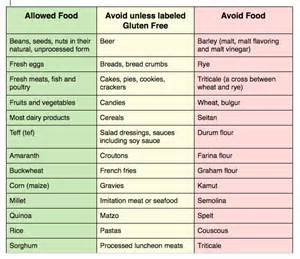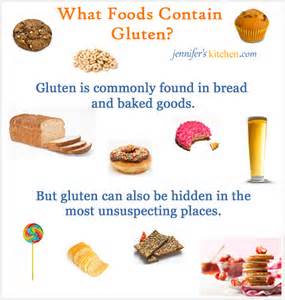Foods Containing Gluten That Must Be Avoided
The list of foods that contain gluten is very comprehensive. It shows a list of all foods and alcoholic and non-alcoholic drinks that need to be avoided while on the gluten free diet. Avoiding some of these foods and drinks may be difficult at first because you may have been eating and drinking them while growing up.
It’s important that you get in the habit of reading the ingredients on the label first before purchasing any gluten free product online or in the grocery store. You must be aware that there are some ingredients that can cause you some reaction or harm because of some hidden gluten in the ingredients. If they are ingested they can cause a reaction even though the product is gluten free. Knowing what’s in the foods you eat and how it was manufactured is a must.
List of foods containing gluten includes…
- Products to be avoided
- Mouth contaminated products
- Foods to be avoided unless they are clearly labeled gluten free
- Alcoholic beverages
- Cross contamination concerns
Video of Hidden Gluten & Foods To Avoid
If the information on the label is not clear enough, it’s always safe to contact the manufacture to ensure that the product is gluten free and safe to be consumed. Usually, their is a phone number and address is printed somewhere on the package. It’s a good practice to follow when the labels are not clearly identified as gluten free to contact the manufacture before consumption.
For continued reading, the following topics will be covered. Just click on a topic of interest and you will be taken directly to that section. Or, just scroll down to view them all.
- Products to Be Avoided
- Avoid These Foods Unless Clearly Labeled Gluten Free
- Mouth Contaminated Products
- Alcoholic Beverages
- Cross-Contamination Concerns
- Conclusion
Products To Be Avoided
The following is a list of foods and drinks that should be avoided if they contain:
- Barley (malt, malt flavoring and malt vinegar are usually made from barley)
- Rye
- Triticale (a cross between wheat and rye)
- Wheat
Avoiding wheat may be challenging because wheat products go by numerous titles. Consider the many types of wheat flour on the supermarket shelves—bromated, enriched, phosphate, plain and self-rising.
Here are some additional wheat products to be avoided:
- Bulgur (used in soaps, pilafs, bakery goods and stuffing)
- Durum flour (used in bread)
- Einkorn wheat
- Emmer
- Farina (used in breakfast cereals and pasta)
- Farro
- Graham flour (used in pie crusts and graham crackers)
- Kamut (used in baking)
- Semolina (used in grits and cream of wheat)
- Spelt (used in beer, pasta, and bread)
- Wheat berries
Back to List of Foods Containing Gluten Topics.
Avoid These Foods Unless Clearly Labeled Gluten Free
Below is a list of foods and ingredients that should be avoided eating unless the product is clearly labeled gluten free.
- Beer
- Breads include: Croissants, Pita, Naan, Bagels, Flatbreads, Cornbread, Potato Bread, Muffins, Donuts, Rolls
- Breakfast foods such as: Pancakes, Waffles, French Toast, Crepes, and Biscuits
- Brewer’s Yeast
- Cakes and pies
- Candy and candy bars
- Cereals
- Cookies and crackers
- Croutons
- Dextrin or starch
- French fries
- Gravies
- Granola
- Imitation meat or seafood
- Matzo
- Meat substitutes
- Pastas
- Potato chips (seasonings may contain gluten)
- Processed luncheon meats
- Salad dressings
- Sauces, including soy sauce
- Seasoned rice mixes
- Seasoned snack foods, such as potato and tortilla chips
- Self-basting poultry
- Soups and soup bases
- Vegetables in sauce
- Wheat Flour
- Wheat starch (that has not been processed to remove presence of gluten to below 20ppm)
Oats are a gluten free grain by themselves. However, they can become contaminated with wheat (gluten) during the growing and processing stages of production. Avoid eating oats unless the product is specifically labeled gluten free.
To be safe, always contact the manufacture before purchase to ensure that the product is gluten free. The reason for this is, your health is at stake.
Another factor to consider, did the manufacture prepare the product on gluten free equipment and in a gluten free facility. Otherwise, the product can become cross-contaminated with gluten.
Back to List of Foods Containing Gluten Topics.
Mouth Contaminated Products
You should avoid any of the following products that come in contact with your mouth unless clearly labeled gluten free:
- Communion wafers (Unless marked gluten free)
- Lipstick (some lipsticks use gluten as a binding agent)
- Lipgloss & Lipbalm (Unintentionally ingested)
- Hairspray, and shampoo
- Lotions
- Drugs and over-the-counter medications
- Food additives, such as malt flavoring, modified food starch and others
- Herbal or nutritional supplements
- Vitamins & mineral supplements that use gluten as a binding agent
- Play dough (children have a tendency of placing their hands in their mouths after playing with it)
If you are not sure the product is gluten free, contact the manufacture first before purchasing.
As you can see, you can get gluten into your body not by just eating. Be sure the lipstick, medications, and vitamin supplements do not have any gluten in them or being used as a binding agent.
Back to List of Foods Containing Gluten Topics.
Alcoholic Beverages
Many types of alcoholic beverages are considered gluten free, provided no coloring’s or other additives have been added during the process as these ingredients may contain gluten. Drinking spirits made from grains should be avoided, unless they are clearly labeled gluten free.
All spirits made without any grains are gluten free and are safe to consume. Liqueurs and pre-mixed drinks should be examined carefully for gluten-derived ingredients before consuming them.
Back to List of Foods Containing Gluten Topics.
Cross-Contamination Concerns
The following is a list of places and areas where cross-contamination can take place since they can come in contact with food containing gluten during processing or cooking:
- Toasters (Used for both gluten and gluten free breads)
- Flour Sifters
- Deep Fried Foods (Oil that can be shared with breaded products)
- Shared Containers
- Condiments (Includes butter, peanut butter, jam, mustard, and mayonnaise with utensils used on gluten food are doubled dipped)
- Wheat Flour
- Oats (Unless it’s clearly labeled gluten free)
- Pizza (Pizzerias that offer gluten free crusts sometimes do not control for cross-contamination with their wheat products by cooking both in the same oven)
- French Fries
- Non-Certified Baked Goods
- Bulk Bins in grocery stores
- Counter-tops at home
- Breadboard
- Pots and pans
- Utensils being used for both gluten and gluten free meals
- Not washing hands after touching gluten foods before working with gluten free products
Cross-contamination occurs very easily and if you fail to control it, it becomes difficult for anyone that suffers from gluten allergies or has celiac disease not to be affected. It is imperative that cross-contamination be avoided completely or as much as possible.
Back to List of Foods Containing Gluten Topics.
Conclusion
Now you know the products, foods and ingredients that need to be avoided if you are on a totally gluten free diet. Many of the foods sold in stores that contain these ingredients just happen to be some of your favorites since your childhood and trying to eliminate them from the diet may be difficult at first.
Remember, if you have been diagnosed with celiac disease or have gluten allergies, you must avoid eating and drinking gluten contaminated foods, the sooner the better. This will be for your entire life time. This is a hard pill to swallow but it’s good for your body and your health.
When you are unable to verify any of the ingredients for a food item or if the ingredient list is unavailable do not eat it or buy it. Adopting a strict gluten free diet is the only known treatment for those with gluten-related disorders.
Here is a link you can refer to for more information about gluten and its effects on humans. Check out this great resource at Gluten Free Diet Sources website.
There are more and more grocery stores today that are now carrying a larger variety of gluten free items for consumption. This is a huge plus when having to plan the meals for the family member or members who have this disease because it offers a greater variety of entrees and products to select from. As more items are being offered, it will help bring down the costs for gluten free products.
Back to List of Foods Containing Gluten Topics.
Shop Gluten Free Food Resources
Back to List of Foods Containing Gluten Topics.
Go back to the Gluten Free Diet With Nutrition Home Page.



